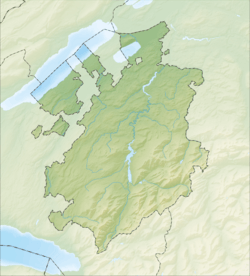Corpataux-Magnedens facts for kids
Quick facts for kids
Corpataux-Magnedens
|
||
|---|---|---|
|
||
| Country | Switzerland | |
| Canton | Fribourg | |
| District | Sarine | |
| Area | ||
| • Total | 4.47 km2 (1.73 sq mi) | |
| Elevation | 687 m (2,254 ft) | |
| Population
(December 2020)
|
||
| • Total | 1,313 | |
| • Density | 293.7/km2 (760.8/sq mi) | |
| Postal code |
1727
|
|
| Surrounded by | Arconciel, Farvagny, Hauterive, Rossens | |
Corpataux-Magnedens was a small town, also known as a municipality, in Switzerland. It was located in the Sarine district, which is part of the canton of Fribourg. Most people in Corpataux-Magnedens spoke French.
This municipality was created on January 1, 1999. It was formed when two smaller places, Corpataux and Magnedens, decided to join together. Later, on January 1, 2016, Corpataux-Magnedens merged with four other towns: Farvagny, Le Glèbe, Rossens, and Vuisternens-en-Ogoz. Together, they formed a new, larger municipality called Gibloux.
Contents
Understanding Corpataux-Magnedens
Where was Corpataux-Magnedens located?
Corpataux-Magnedens was a small area, about 4.4 square kilometers (or 1.7 square miles). It was found in the Sarine district.
Most of its land was used for farming, about 57% of the total area. Forests covered almost a quarter of the land, about 24.3%. The remaining land, about 18.5%, was used for buildings, roads, and other developed areas. A small part, about 2.5%, was made up of rivers or lakes.
What did the Coat of Arms look like?
The coat of arms for Corpataux-Magnedens was a special symbol. It showed a red shield with a white "X" shape, like a cross. At the top of the shield, there was a white Maltese Cross, and at the bottom, there was a white ram (a male sheep).
People and Population
How many people lived there?
In 2014, Corpataux-Magnedens had a population of 1,296 people. About 9.9% of these people were foreign nationals living in the town in 2008. Between 2000 and 2010, the population grew by 44.2%. This growth was mostly due to people moving into the area (32.9%) and more births than deaths (9.8%).
What languages did people speak?
In 2000, most people in Corpataux-Magnedens spoke French as their main language, about 92% of the population. The second most common language was German, spoken by about 5.6% of residents. A small number of people, about 0.9%, spoke Italian.
Who lived in Corpataux-Magnedens?
In 2008, the population was almost evenly split between males and females. About 51.9% were male, and 48.1% were female.
In 2000, about 35.7% of the people living in Corpataux-Magnedens were born there. Another 42.9% were born in the same canton (Fribourg). About 9.6% were born elsewhere in Switzerland, and 8.1% were born outside of Switzerland.
Age groups and families
In 2000, children and teenagers (ages 0-19) made up 26.8% of the population. Adults (ages 20-64) were the largest group at 64%. Seniors (over 64 years old) made up 9.2%.
There were 287 private households in 2000, with an average of 2.8 people per household. About 52 households had only one person, and 30 households had five or more people. Most apartments (93.9%) were lived in all year round.
The historical population is shown in the chart below:

Economy and Jobs
What kind of jobs were there?
In 2010, the unemployment rate in Corpataux-Magnedens was 3.9%. This means a small number of people who wanted to work couldn't find a job.
In 2008, there were 68 full-time jobs in the municipality. These jobs were spread across different types of industries:
- Primary Sector: This includes jobs related to getting raw materials, like farming. There were 20 jobs in agriculture.
- Secondary Sector: This involves making things, like in factories or construction. There were 20 jobs, with 16 in manufacturing and 4 in construction.
- Tertiary Sector: This is the service sector, like shops, hotels, or education. There were 28 jobs in this sector. Some examples include jobs in transportation, hotels, science, and education.
How did people get to work?
In 2000, many people who lived in Corpataux-Magnedens worked outside the municipality (356 people). Only a few workers (24 people) came into the municipality for their jobs. This means more people left the town for work than came into it.
Most people (77.6%) used a private car to get to work. About 8.3% used public transportation.
Beliefs and Education
What religions were practiced?
According to the 2000 census, most people in Corpataux-Magnedens were Roman Catholic, making up about 80.5% of the population. About 5.5% belonged to the Swiss Reformed Church. There were also smaller groups of people who were Orthodox Christian or belonged to other Christian churches. A small number of people were Islamic. About 3.74% of the population did not follow any religion or did not answer the question.
How was education structured?
In Switzerland, the education system starts with one year of non-required Kindergarten. After that, students attend six years of Primary school. Then, they go to three years of lower Secondary school. In lower Secondary, students are grouped based on their abilities.
After lower Secondary, students can choose to go to an optional upper Secondary school for three or four years. This can be a gymnasium (which prepares students for university) or a vocational program (which teaches job skills). After upper Secondary, students can go to a higher education school or continue their apprenticeship (on-the-job training).
In 2010-2011, there were 118 students in 6 classes in Corpataux-Magnedens. There was one kindergarten class with 18 students and five primary classes with 100 students. While there were no lower secondary classes in the municipality itself, 46 students attended lower secondary school in nearby towns. Many students also traveled to other municipalities for upper secondary education or specialized training.
See also
 In Spanish: Corpataux-Magnedens para niños
In Spanish: Corpataux-Magnedens para niños




